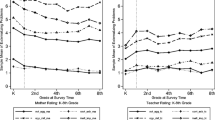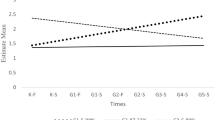Abstract
The aim of this study was to examine the prediction of adult behavioral and emotional problems from developmental trajectories of externalizing behavior in a 24-years longitudinal population-based study of 2,076 children. The adult psychiatric outcome of these trajectories has not yet been examined. Trajectories of the four externalizing behavior types: aggression, opposition, property violations and status violations were determined separately through latent class growth analysis using data of five waves, covering ages 4–18 years. We used regression analyses to determine the associations between children’s trajectories and adults’ psychiatric problems based on the Adult Self-Report. The developmental trajectories of the four types of externalizing behavior mostly predicted intrusive, aggressive and rule-breaking behavior in adulthood. Non-destructive behaviors in childhood such as opposition and status violations predict adult problems to a larger extent than destructive behaviors such as aggression and property violations. In general, children who develop through high-level trajectories are likely to suffer from both internalizing and externalizing problem behavior in adulthood, regardless the direction of change (i.e. increasing/decreasing/persisting) of the high-level trajectory. We can conclude that the level rather than the developmental change of externalizing behavior problems has a larger impact on adult outcome.


Similar content being viewed by others
References
Achenbach TM (1991) Manual for the child behavior checklist/4–18 and 1991 child profile. Department of Psychiatry, University of Vermont, Burlington
Achenbach TM (1997) Manual for the young adult self-report and young adult behavior checklist. Department of Psychiatry, University of Vermont, Burlington
Achenbach TM, Dumenci L, Rescorla LA (2001) Ratings of relations between DSM-IV diagnostic categories and items of the CBCL/6-18, TRF, and YSR. University of Vermont, Research center for children, youth, and families, Burlington, Vermont
American Psychiatric Association (1994) Diagnostic and statistical manual of mental disorders (4th edn). Washington, DC, USA
Angold A, Costello EJ, Erkanli A (1999) Comorbidity. J Child Psychol Psychiatry 40:57–87
Bongers IL, Koot HM, van der Ende J, Verhulst FC (2004) Developmental trajectories of externalizing behaviors in childhood and adolescence. Child Dev 75:1523–1537
Bongers IL, Koot HM, van der Ende J, Verhulst FC (2003) The normative development of child and adolescent problem behavior. J Abnorm Psychol 112:179–192
Bongers IL, Koot HM, van der Ende J, Verhulst FC (2008) Predicting young adult social functioning from developmental trajectories of externalizing behaviour. Psychol Med 38:989–999
Brame B, Nagin DS, Tremblay RE (2001) Developmental trajectories of physical aggression from school entry to late adolescence. J Child Psychol Psychiatry 42:503–512
Broidy LM, Nagin DS, Tremblay RE, Bates JE, Brame B, Dodge KA, Fergusson D, Horwood JL, Loeber R, Laird R, Lynam DR, Moffitt TE, Pettit GS, Vitaro F (2003) Developmental trajectories of childhood disruptive behaviors and adolescent delinquency: a six-site, cross-national study. Develop Psychol 39:222–245
Dodge KA, Coie JD (1987) Social-information-processing factors in reactive and proactive aggression in children’s peer groups. J Pers Soc Psychol 53:1146–1158
Dodge KA, Lochman JE, Harnish JD, Bates JE, Pettit GS (1997) Reactive and proactive aggression in school children and psychiatrically impaired chronically assaultive youth. J Abnorm Psychol 106:37–51
Fergusson DM, Horwood LJ, Ridder EM (2007) Conduct and attentional problems in childhood and adolescence and later substance use, abuse and dependence: results of a 25-year longitudinal study. Drug Alcohol Depend 88(Suppl 1):S14–S26
Fergusson DM, Horwood LJ, Ridder EM (2005) Show me the child at seven: the consequences of conduct problems in childhood for psychosocial functioning in adulthood. J Child Psychol Psychiatry 46:837–849
Frick PJ, Lahey BB, Loeber R, Tannenbaum L, Van Horn Y, Christ MAG, Hart EL, Hanson K (1993) Oppositional defiant disorder and conduct disorder: a meta-analytic review of factor analyses and cross-validation in a clinic sample. Clin Psychol Rev 13:319–340
Kim-Cohen J, Caspi A, Moffit TE, Harrington H, Milne BJ, Poulton R (2003) Prior Juvenile diagnoses in adults with mental disorder. Arch Gen Psychiatry 60:709–717
Mannuzza S, Klein RG, Moulton JL 3rd (2008) Lifetime criminality among boys with attention deficit hyperactivity disorder: a prospective follow-up study into adulthood using official arrest records. Psychiatry Res 160:237–246
Moffitt TE (1993) Adolescence-limited and life-course-persistent antisocial behavior: a developmental taxonomy. Psychol Rev 100:674–701
Moffitt TE, Caspi A (2001) Childhood predictors differentiate life-course persistent and adolescence-limited antisocial pathways among males and females. Develop Psychopathol 13:355–375
Moffitt TE, Caspi A, Harrington H, Milne BJ (2002) Males on the life-course-persistent and adolescence-limited antisocial pathways: follow-up at age 26 years. Develop Psychopathol 14:179–207
Nagin DS (1999) Analyzing developmental trajectories: a semiparametric, group-based approach. Psychol Methods 4:139–157
Nagin DS, Tremblay RE (1999) Trajectories of boys’ physical aggression, opposition, and hyperactivity on the path to physically violent and nonviolent juvenile delinquency. Child Dev 70:1181–1196
Nock MK, Kazdin AE, Hiripi E, Kessler RC (2007) Lifetime prevalence, correlates, and persistence of oppositional defiant disorder: results from the National Comorbidity Survey Replication. J Child Psychol Psychiatry 48:703–713
Odgers CL, Caspi A, Broadbent JM, Dickson N, Hancox RJ, Harrington H, Poulton R, Sears MR, Thomson WM, Moffitt TE (2007) Prediction of differential adult health burden by conduct problem subtypes in males. Arch Gen Psychiatry 64:476–484
Odgers CL, Moffitt TE, Broadbent JM, Dickson N, Hancox RJ, Harrington H, Poulton R, Sears MR, Thomson WM, Caspi A (2008) Female and male antisocial trajectories: from childhood origins to adult outcomes. Develop Psychopathol 20:673–716
Roisman GI, Aguilar B, Egeland B (2004) Antisocial behavior in the transition to adulthood: the independent and interactive roles of developmental history and emerging developmental tasks. Develop Psychopathol 16:857–871
Simonoff E, Elander J, Holmshaw J, Pickles A, Murray R, Rutter M, Silberg J, O’Connor T, Meyer J, Maes H (2004) Predictors of antisocial personality: continuities from childhood to adult life. Br J Psychiatry 184:118–127
Sourander A, Jensen P, Davies M, Niemela S, Elonheimo H, Ristkari T, Helenius H, Sillanmaki L, Piha J, Kumpulainen K, Tamminen T, Moilanen I, Almqvist F (2007) Who is at greatest risk of adverse long-term outcomes? The Finnish from a Boy to a Man study. J Am Acad Child Adolesc Psychiatry 46:1148–1161
Stanger C, Achenbach TM, Verhulst FC (1997) Accelerated longitudinal comparisons of aggressive versus delinquent syndromes. Develop Psychopathol 9:43–58
Timmermans M, van Lier PA, Koot HM (2008) Which forms of child/adolescent externalizing behaviors account for late adolescent risky sexual behavior and substance use? J Child Psychol Psychiatry 49:386–394
Tremblay RE (2000) The development of aggressive behaviour during childhood: what have we learned in the past century? Int J Behav Develop 24:129–141
Van Meurs I, Reef J, Verhulst F, van der Ende J (2008) Intergenerational transmission of child problem behaviors: a longitudinal, population-based study. J Am Acad Child Adolesc Psychiatry 48(2):138–145
van Westerlaak JH, Kropman JA, Collaris JWM (1975) Beroepenklapper (Manual for occupational level). Instituut voor Sociologie, Nijmegen
Vanheusden K, van der Ende J, Mulder CL, van Lenthe FJ, Verhulst FC, Mackenbach JP (2009) Beliefs about mental health problems and help-seeking behavior in Dutch young adults. Soc Psychiatry Psychiatr Epidemiol 44:239–246
Verhulst FC, van der Ende J, Koot HM (1996) Handleiding voor de CBCL/4-18 (Manual for the CBCL/4-18). Erasmus University/Department of Child and Adolescent Psychiatry, Sophia Children’s Hospital, Rotterdam
Vitaro F, Brendgen M, Tremblay R (2002) Reactively and proactively aggressive children: antecedent and subsequent characteristics. J Child Psychol Psychiatry 43:495–505
Zoccolillo M (1992) Cooccurrence of conduct disorder and its adult outcomes with depressive and anxiety disorders—a review. J Am Acad Child Adolesc Psychiatry 31:547–556
Zoccolillo M, Pickles A, Quinton D, Rutter M (1992) The outcome of childhood conduct disorder: implications for defining adult personality disorder and conduct disorder. Psychol Med 22:971–986
Author information
Authors and Affiliations
Corresponding author
Rights and permissions
About this article
Cite this article
Reef, J., Diamantopoulou, S., van Meurs, I. et al. Predicting adult emotional and behavioral problems from externalizing problem trajectories in a 24-year longitudinal study. Eur Child Adolesc Psychiatry 19, 577–585 (2010). https://doi.org/10.1007/s00787-010-0088-6
Received:
Accepted:
Published:
Issue Date:
DOI: https://doi.org/10.1007/s00787-010-0088-6




